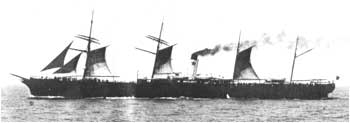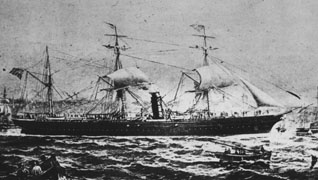Russia - Waesland

One of the corner stones in the Cunard Lineís fleet was the lineís famous conservatism.
Even though Isambard Brunelís spectacular Great Britain had entered
service in 1845 with a screw propeller, Cunard gave their Persia
of 1856 paddle wheels. This ship became a success and she was followed
in 1862 by a near-sister, named Scotia, also relying on the paddle
wheels. The same year, the propeller driven steamer China entered
service, and as she resembled the Scotia, she was perfect to compare
with. After both ships had been in service for some time, it was discovered
that the China was the superior ship, as all the comparisons favoured
her.
In an attempt to convince the public and some conservative shipping companies
that the propeller actually was more efficient than paddle wheels, a test
had been carried out in 1845 between the two almost identical frigates
Rattler and Alecto, both of 880 tons. The propeller driven
Rattler was chained stern-to-stern with the paddle wheel driven
Alecto as the battle begun. Both vessels steamed on at full power
in opposite directions, and the Rattler with her propeller towed the Alecto
stern first with ease at a speed of 2.7 knots. Cunard had to face it.  | | If they were supposed to continue being one of the most
prestigious shipping companies in the world, they had to rely on new technique.
As a result of some new thinking, Cunard was considering their first major
propeller driven unit during the mid-1860s. The new vessel would
be named Russia, and would be almost 3,000 gross tons large, making
her somewhat smaller than the Persia and Scotia.
The Russia was constructed at J. & G. Thomson Limited in Glasgow. She was fitted
with three masts and a single funnel. Without the characteristic look of
the paddle wheels, her sides looked quite bare and naked. Just like her
many predecessors, the Russia |
|
